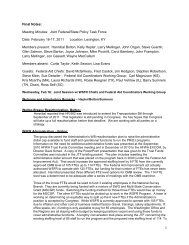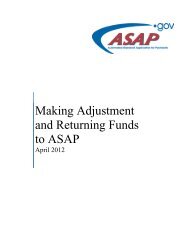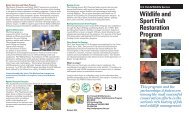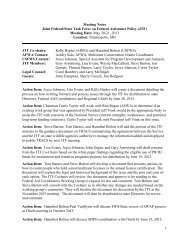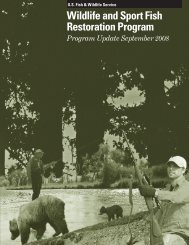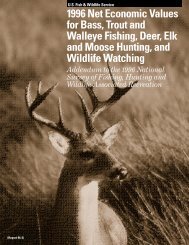Financial Returns To Industry From The Federal Aid - Wildlife and ...
Financial Returns To Industry From The Federal Aid - Wildlife and ...
Financial Returns To Industry From The Federal Aid - Wildlife and ...
You also want an ePaper? Increase the reach of your titles
YUMPU automatically turns print PDFs into web optimized ePapers that Google loves.
Taken together, investing in Conservation, access to the resources, <strong>and</strong> recruitment of<br />
the next generation of sportsmen through your excise taxes has paid huge dividends for<br />
the hunting <strong>and</strong> shooting-sports industries for well over 70 years. Beyond simply<br />
highlighting the multitudes of good projects supported through the years, this report<br />
demonstrates the financial return that investment into the <strong>Wildlife</strong> Restoration excise<br />
taxes brings to your industry.<br />
<strong>The</strong>n <strong>and</strong> Now<br />
<strong>The</strong> “<strong>The</strong>n <strong>and</strong> Now” section of this report illustrates how dire wildlife conservation was<br />
a mere 100 years ago. It further shows the success of programs that are currently in<br />
place across the nation. <strong>The</strong> “Now” portion of that section reflects these dividends. <strong>The</strong><br />
hunting <strong>and</strong> shooting-sports industries, <strong>and</strong> the hunting opportunities, are the byproducts<br />
of abundant, sustainable wildlife populations that result from long-term<br />
investments in Conservation.<br />
Overview of the <strong>Wildlife</strong> Restoration Program<br />
<strong>The</strong> <strong>Wildlife</strong> Restoration Program is often called one of the most successful userpays/user-benefits<br />
programs in the world. <strong>Industry</strong>, through its payment of dedicated<br />
excise taxes, provides the foundation for wildlife management programs, which in turn<br />
benefit hunters who purchase equipment from those same manufacturers. In 2009,<br />
wildlife-related companies provided $484,765,728 for the Pittman-Robertson <strong>Wildlife</strong><br />
Restoration fund from the sale of firearms, archery equipment <strong>and</strong> ammunition.<br />
What Items Are Taxed?<br />
A complete list of items currently subject to the manufacturer‟s excise tax is found in<br />
Appendix A. In general, these items are used predominately by hunters, <strong>and</strong> shooting<br />
enthusiasts. While numerous changes have been made to the items taxed <strong>and</strong> the<br />
various tax rates on specific items, for the most part the core list of items taxed has not<br />
changed substantially since originally being implemented.<br />
Restoration Programs: Unique, Protected <strong>and</strong> Strong<br />
<strong>The</strong> <strong>Wildlife</strong> Restoration Program contains several ingenious provisions that are rarely<br />
found in federal legislation. For example, the act establishing this program captures an<br />
excise tax that was already being paid by manufacturers <strong>and</strong> applies it directly to<br />
programs that benefit recreational hunting <strong>and</strong> shooting activities <strong>and</strong> industries. In<br />
addition, two other provisions deserve mention.<br />
<strong>The</strong> “permanent appropriation” language, now incorporated into the act, is also unique.<br />
This concept, originally included in <strong>Wildlife</strong> Restoration‟s sister program, the Sport Fish<br />
Restoration Program, was so objectionable to politicians that they convinced then-<br />
3




